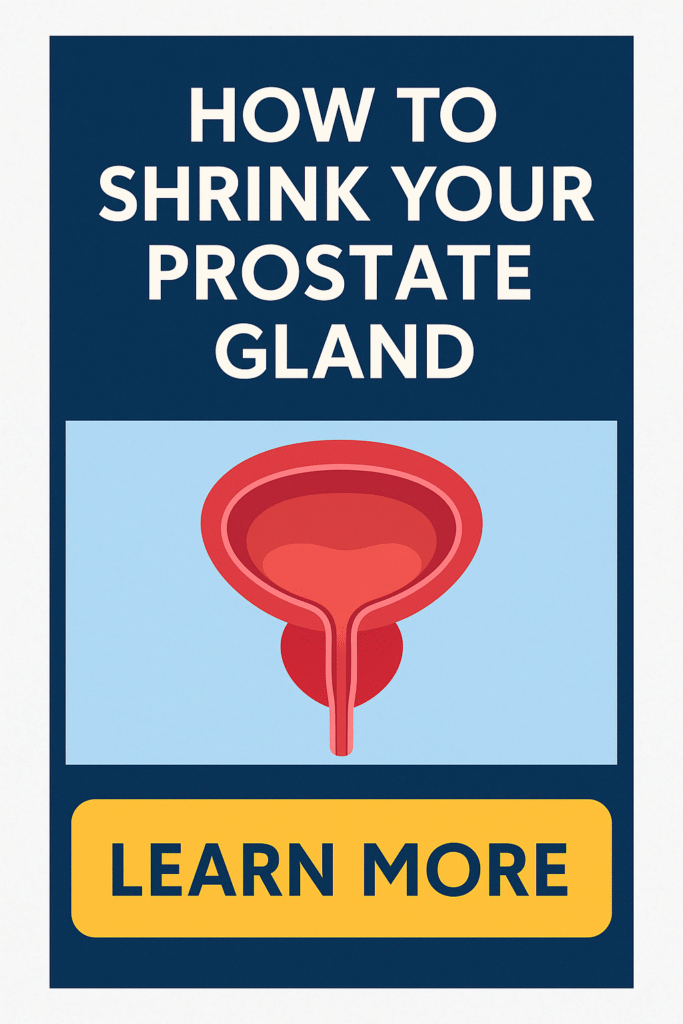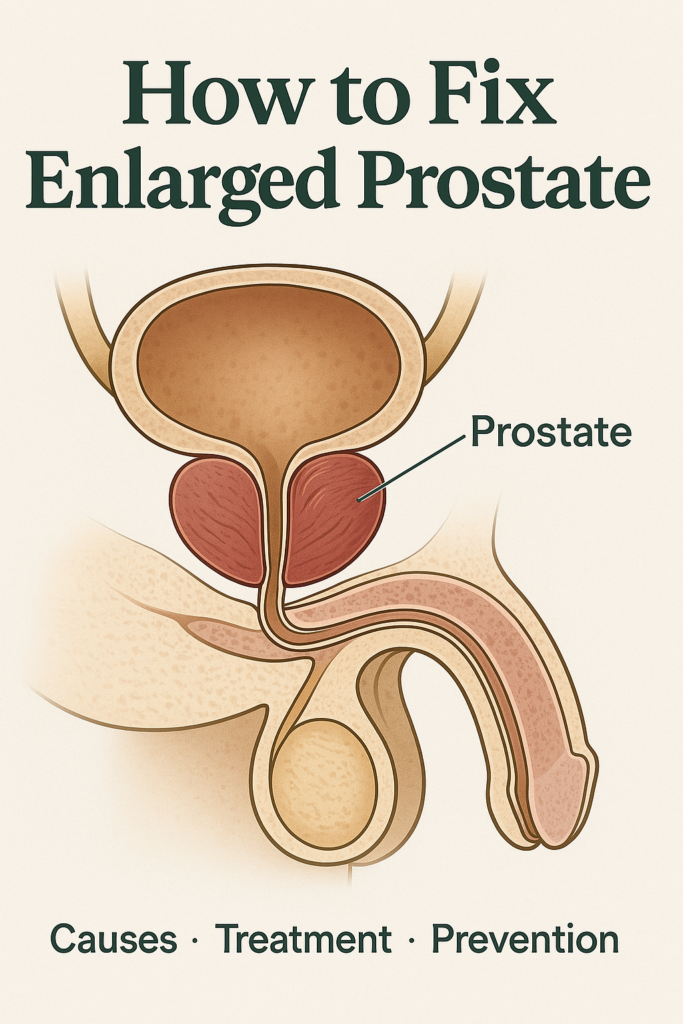Top 10 Natural Ways to Reduce an Enlarged Prostate (Backed by Science)

Imagine facing the constant urgency to urinate, both day and night, affecting your daily life and peace of mind. An enlarged prostate, medically known as Benign Prostatic Hyperplasia (BPH), is a common condition that men encounter as they age, leading to urinary discomfort and challenges. This non-cancerous enlargement of the prostate gland can obstruct urine flow, causing frequent bathroom visits, a weak urinary stream, and difficulty starting urination.
Understanding BPH is crucial because the prostate’s growth can significantly disrupt urinary health, affecting the quality of life and increasing the risk of urinary tract infections. While conventional medications and procedures are available, many individuals seek natural methods to alleviate BPH symptoms effectively. Identifying lifestyle adjustments and natural remedies can provide a holistic approach to managing an enlarged prostate.
In this article, we explore ten scientifically-backed natural ways to reduce an enlarged prostate. From diet alterations and herbal supplements to exercise and stress management, these strategies aim to promote prostate health and improve urinary function. Relay on these actionable tips, encouraging small, daily steps towards a healthier you.
Tired of Constant Bathroom Trips?
If you’re seeking natural relief from prostate discomfort, ProstaVive might be the solution you’ve been looking for.
What is an Enlarged Prostate (BPH)?
An enlarged prostate, medically known as Benign Prostatic Hyperplasia (BPH), is a common condition where the prostate gland increases in size. This gland, found only in men, is located just below the bladder and surrounds the urethra—the tube through which urine exits the body. As the prostate enlarges, it can squeeze or partially block the urethra, affecting urinary health.
Common urinary symptoms associated with BPH include a weak urine stream, frequent urination, especially at night (nocturia), and painful urination. These symptoms can impact a man’s quality of life, leading to discomfort and interrupted daily activities.
Understanding BPH is crucial as it helps differentiate between benign enlargement and more serious conditions like prostate cancer. Thankfully, there are various ways to manage BPH, including medical treatments and natural remedies. By recognizing its symptoms early, individuals can seek appropriate interventions to reduce urinary tract symptoms and promote overall prostate health.
Eat a Prostate-Friendly Diet
An enlarged prostate, or Benign Prostatic Hyperplasia (BPH), can significantly impact urinary health, causing a weak urine stream, frequent urination, and even painful urination. To manage these symptoms naturally, adjusting your diet can be beneficial.
Certain foods are known to reduce inflammation and bolster prostate health:
- Tomatoes: Rich in lycopene, a powerful antioxidant, tomatoes can help lower prostate PSA levels and support overall prostate health.
- Berries: Berries like strawberries, blueberries, and raspberries contain antioxidants, which protect against cellular damage and may reduce prostate swelling.
- Cruciferous Vegetables: Foods like broccoli and kale are packed with nutrients that may have protective effects on prostate health.
However, it’s advisable to limit:
- Red Meat and Processed Foods: These can exacerbate inflammation and worsen urinary symptoms.
Here’s a quick reference:
| Foods to Embrace | Foods to Avoid |
|---|---|
| Tomatoes (Lycopene) | Red Meat |
| Berries (Antioxidants) | Processed Foods |
| Cruciferous Vegetables |
A balanced diet focusing on these beneficial foods can naturally support prostate health and potentially reduce the symptoms of an enlarged prostate.
Incorporate Herbal Supplements
When dealing with an enlarged prostate, also known as Benign Prostatic Hyperplasia (BPH), incorporating herbal supplements can offer natural relief for urinary symptoms. Below is an overview of four supplements known for their prostate health benefits:
| Supplement | Benefits for Prostate Health and Urinary Symptoms |
|---|---|
| Saw Palmetto | Helps reduce prostate inflammation, improving urine flow. |
| Beta-Sitosterol | Known for enhancing urinary flow and reducing painful urination. |
| Pygeum | Alleviates urinary symptoms like nighttime urination and improves overall urinary health. |
| Stinging Nettle | Its anti-inflammatory properties help reduce prostate swelling and improve urinary symptoms. |
- Saw Palmetto is derived from the berries of the Serenoa repens plant. It has shown effectiveness in reducing symptoms like weak urine stream and frequent urination.
- Beta-Sitosterol is a plant sterol offering relief by targeting urinary symptoms and improving quality of life for those affected by BPH.
- Pygeum originates from the bark of the African cherry tree and is utilized for its ability to improve urinary tract symptoms and maintain prostate health.
- Stinging Nettle works by lowering prostate PSA levels and providing relief from inflammation, contributing to better urinary flow.
Incorporating these supplements could be a beneficial addition to managing prostate health naturally. Always consult a healthcare provider before starting any new treatment options.
Natural Solution Backed by Science
Supplements like Saw Palmetto are great — but why not get a complete formula in one capsule? ProstaVive combines top ingredients in a single, convenient solution.
Stay Hydrated – The Right Way
Maintaining proper hydration is crucial for overall health and can positively impact prostate health. It ensures optimal urine flow and reduces the risk of urinary tract infections.
However, if you’re dealing with an enlarged prostate, known medically as Benign Prostatic Hyperplasia (BPH), it’s important to manage your fluid intake to prevent worsening urinary symptoms.
Here’s how to do it:
- Stay Hydrated During the Day: Ensure adequate water intake throughout the day to maintain hydration levels without burdening your bladder at night.
- Limit Evening Fluids: Avoid drinking large amounts of fluids in the evening. This can help prevent frequent nighttime urination, known as nocturia, a common symptom of BPH.
- Avoid Caffeine and Alcohol: Both can irritate the bladder and exacerbate urinary symptoms. Reducing these can improve your quality of life significantly.
Hydration Tips:
| Time of Day | Recommended Action |
|---|---|
| Morning to Afternoon | Drink regularly, focus on water |
| Late Afternoon | Start reducing fluid intake |
| Evening | Limit fluids, especially caffeine and alcohol |
By following these guidelines, you can help manage urinary symptoms associated with an enlarged prostate while ensuring you stay adequately hydrated.
Exercise Regularly
Regular physical activity plays a crucial role in maintaining prostate health and can significantly reduce symptoms associated with an enlarged prostate, medically known as Benign Prostatic Hyperplasia (BPH). Engaging in exercises such as walking, swimming, and pelvic floor exercises (Kegel exercises) can help improve urinary flow and manage symptoms like frequent or painful urination.
Benefits of Regular Exercise for Enlarged Prostate:
- Walking: Just 30 minutes of brisk walking a day can enhance circulation, decrease prostate inflammation, and improve overall urinary tract symptoms.
- Swimming: Provides a low-impact workout that can strengthen the body without exerting direct pressure on the prostate.
- Kegel Exercises: Strengthen pelvic floor muscles, promoting better control over urination and reducing symptoms like a weak urine stream. Here’s how to perform them:
- Identify pelvic muscles by stopping urine flow midstream.
- Contract these muscles for 5 seconds, then relax for 5 seconds.
- Aim for 10 repetitions, three times daily.
These activities not only improve prostate symptoms but also enhance overall quality of life by boosting energy, reducing stress, and lowering the risk of prostate cancer. Make these exercises a part of your routine to enjoy their protective effects on prostate health.
Maintain a Healthy Weight
An enlarged prostate, medically known as Benign Prostatic Hyperplasia (BPH), can lead to uncomfortable urinary symptoms such as frequent urination, weak urine stream, and painful urination. Research shows that obesity is closely linked to exacerbated prostate symptoms, making weight management crucial for prostate health.
Losing excess weight through a balanced diet and regular exercise is a natural and effective way to reduce prostate enlargement and improve urinary flow. Maintaining a healthy weight helps regulate insulin and hormone levels, both of which play a role in the development of prostate issues.
Benefits of Weight Management:
| Benefits | Impact on Prostate Health |
|---|---|
| Improved Insulin Sensitivity | May reduce prostate inflammation and swelling. |
| Hormonal Balance | Lowers risk of prostate enlargement. |
| Decrease in Abdominal Fat | Reduces pressure on the bladder, easing symptoms. |
Engaging in physical activities like walking or swimming, combined with a diet rich in fruits, vegetables, and healthy fats, can significantly improve prostate symptoms and enhance quality of life. By maintaining a healthy weight, you not only address urinary symptoms but also contribute to overall prostate and metabolic health.
Reduce Stress and Improve Sleep

Stress triggers the release of hormones such as cortisol and adrenaline, which can lead to increased inflammation in the body. Prolonged stress causes an imbalance in these hormones, negatively affecting the immune system and overall health.
Engaging in regular breathing exercises can help calm the nervous system and reduce stress hormone levels. These exercises promote relaxation by activating the parasympathetic nervous system, which counteracts the body’s stress response.
Yoga is another effective practice that combines physical postures with mindfulness and deep breathing. It has been shown to lower stress levels and reduce inflammation, improving both mental and physical well-being.
Proper sleep hygiene is crucial in managing stress and maintaining hormonal balance. It involves creating a restful environment and establishing a consistent sleep schedule. This helps regulate the sleep-wake cycle, ensuring restorative sleep.
Simple Tips for Better Sleep:
- Establish a regular sleep schedule.
- Create a relaxing bedtime routine.
- Limit screen time before bed.
- Keep bedroom cool and dark.
- Avoid caffeine and heavy meals before bedtime.
By incorporating these practices, you can effectively manage stress and enhance sleep quality, promoting better overall health.
Avoid Prostate Irritants
An enlarged prostate, medically known as Benign Prostatic Hyperplasia (BPH), can frequently disrupt urinary health by causing discomfort in the urinary tract. Common irritants can exacerbate these symptoms, increasing prostate pressure and inflammation.
Here’s a quick guide to avoiding prostate irritants:
| Irritant | Effect on Prostate |
|---|---|
| Spicy Food | Increases prostate irritation |
| Alcohol | Leads to enlarged prostate symptoms |
| Caffeine | Causes frequent urination |
| Smoking | Heightens inflammation risk |
Recommendations:
- Limit or Remove Spicy Foods: These can irritate the bladder and prostate.
- Reduce Alcohol Consumption: Alcohol can cause an enlarged prostate to become overactive.
- Cut Back on Caffeine: Found in coffee and tea, caffeine can worsen urinary frequency and urgency.
- Quit Smoking: Smoking is linked to numerous health issues, including increased inflammation in the prostate area.
By avoiding or minimizing these irritants, you may find relief from uncomfortable urinary symptoms and support overall prostate health. Incorporating these changes can be a simple yet effective step towards improving your quality of life naturally.
Bladder Training Techniques
Bladder training is an effective strategy to manage urinary symptoms, especially for those experiencing frequent urination and urgency due to an enlarged prostate or other urinary tract issues.
Double Voiding Technique
- What It Is: A method to ensure the bladder is thoroughly emptied.
- How It Helps: Reduces the volume of leftover urine, thus minimizing urgency.
- How-To:
- After urinating, wait a few moments.
- Try to urinate again to fully empty the bladder.
Timed Urination Technique
- What It Is: Urinating on a schedule instead of waiting for the urge.
- How It Helps: Increases control over bladder function and urgency.
- How-To:
- Determine a schedule, such as every 2 to 4 hours.
- Gradually extend the time between visits as control improves.
Comparison Table
| Technique | Benefits | Steps |
|---|---|---|
| Double Voiding | Reduces urgency | Urinate, pause, urinate again |
| Timed Urination | Improves control | Schedule and extend urination intervals |
Implementing these techniques can enhance urinary control and improve quality of life for those facing persistent urinary symptoms.
Track Symptoms and Urinary Habits
An enlarged prostate, medically known as Benign Prostatic Hyperplasia (BPH), can significantly impact urinary health, leading to troublesome symptoms such as a weak urine stream, frequent and painful urination, and persistent nighttime urination. Managing these symptoms effectively is crucial to maintaining a good quality of life.
To better understand and manage your symptoms, keeping a symptom journal can be invaluable. By recording your daily urinary habits, you can identify specific triggers and track your progress over time. This can provide not only personal insights but also valuable information to share with your healthcare provider when discussing treatment options.
Here’s how you can efficiently track your symptoms:
Suggested Tracking Tools
- Mobile Apps: Utilize apps designed for symptom tracking that offer easy input and insightful analytics.
- Simple Log: Keep a small notebook by your side where you jot down occurrences and note any changes in symptoms.
What to Track
- Instances of frequent urination
- Any episodes of painful urination
- Changes in urine flow and stream strength
- Instances of nighttime urination
By diligently tracking your symptoms, you can take a proactive approach to managing BPH, ultimately finding effective natural remedies and improving your urinary health.
Know When to See a Doctor
An enlarged prostate, also known as Benign Prostatic Hyperplasia (BPH), is a common condition where the prostate gland experiences non-cancerous growth. This can lead to urinary symptoms such as a weak urine stream, frequent urination, and the urgent need to urinate, particularly at night.
While natural remedies can be effective, recognizing red flags is crucial in managing prostate health.
Red Flags to Watch For:
- Persistent Pain: Continuous pain in the lower abdomen or during urination should not be ignored.
- Blood in Urine: The presence of blood can indicate a serious issue that requires immediate professional evaluation.
- Inability to Urinate: Sudden difficulty or inability to urinate is a critical sign that needs urgent medical attention.
If these symptoms worsen or do not improve with natural remedies, it is important to consult a healthcare professional. While maintaining a natural approach is beneficial, ensuring a balanced treatment plan with professional guidance is key to preserving urinary and prostate health. It’s all about taking proactive steps while staying calm and informed about one’s health.
ProstaVive: A Natural Supplement Worth Considering
Dealing with an enlarged prostate, medically known as Benign Prostatic Hyperplasia (BPH), can significantly impact urinary health, leading to issues such as a weak urine stream, frequent urination, and nighttime urination. Managing these symptoms is crucial for maintaining quality of life.
ProstaVive is a natural supplement designed to address prostate symptoms and support prostate health. It stands out by incorporating clinically backed herbs and nutrients, such as Saw Palmetto and Lycopene, known for their protective effects on the prostate gland.
Key Ingredients:
- Saw Palmetto: Traditionally used in herbal remedies to alleviate urinary tract symptoms and reduce prostate swelling, potentially lowering the risk of prostate cancer.
- Lycopene: A powerful antioxidant believed to promote a healthy flow of urine and support overall prostate health.
These ingredients work synergistically, offering a promising option for those seeking to naturally reduce prostate inflammation and enhance urinary flow.
For a comprehensive evaluation, the full review delving deeper into the benefits and efficacy of ProstaVive can be found here. Exploring this supplement’s potential could be a key step in managing BPH effectively.
Take Control of Your Prostate Health
Thousands of men are choosing ProstaVive for natural, effective prostate support. With ingredients backed by science, it’s time to join them.
You Should Consider Using Prostavive Because;

ProstaVive is a promising natural supplement designed to aid men suffering from prostate enlargement symptoms. Its formulation, supported by scientific research, harnesses the power of natural ingredients known to improve prostate health and enhance urinary function. Key ingredients such as saw palmetto extract, pumpkin seed oil, and zinc work together to alleviate symptoms, promoting a healthier flow of urine and reducing nighttime urination.
Here’s why ProstaVive stands out:
- Natural Ingredients: Contains potent herbal extracts and essential nutrients that are gentle yet effective.
- Scientifically Backed: Supported by multiple studies highlighting its protective effects on prostate health.
- User Satisfaction: Numerous positive testimonials praise its ability to ease urinary symptoms and increase comfort.
With ProstaVive, you’re choosing a trusted option many have found life-changing. Don’t let prostate issues dictate your quality of life any longer. Visit the official ProstaVive website to learn more and make your purchase today. Take control of your prostate health naturally!
Ready to Start Feeling Better?
ProstaVive helps reduce nighttime urination, supports healthy flow, and improves your quality of life — all naturally.
Summarize the 10 natural tips and encourage men to take small, daily steps. End with a motivating and confident tone.

An enlarged prostate, known as Benign Prostatic Hyperplasia (BPH), is a common condition in men as they age. It affects urinary health, causing symptoms like a weak urine stream, frequent or painful urination, and nighttime urination. Fortunately, there are natural ways to address these issues.
Top 10 Natural Tips to Reduce an Enlarged Prostate:
- Pumpkin Seeds: High in zinc, they support prostate health.
- Saw Palmetto Extract: Reduces symptoms and enhances urine flow.
- Dietary Adjustments: Incorporate more fruits, vegetables, and healthy fats.
- Herbal Supplements: Includes pygeum and rye-grass pollen extracts.
- Hydration: Drink enough water, but limit fluid intake close to bedtime.
- Avoid Caffeine and Alcohol: They can irritate the bladder.
- Exercise Regularly: Promotes general health and can alleviate symptoms.
- Limit Red Meat Intake: Choose lean proteins instead.
- Soy Products: Contain isoflavones beneficial for prostate health.
- Maintain a Healthy Weight: Reduces pressure on the bladder.
Implementing these tips can help improve urinary symptoms and enhance overall quality of life. Start by integrating small steps every day, and watch as your prostate health transforms. Stay committed to these changes, and feel confident on your path to better well-being.
Ready to Reclaim Your Comfort?
ProstaVive has helped thousands of men regain control of their bladder and improve quality of life. Don’t wait—experience relief for yourself.







